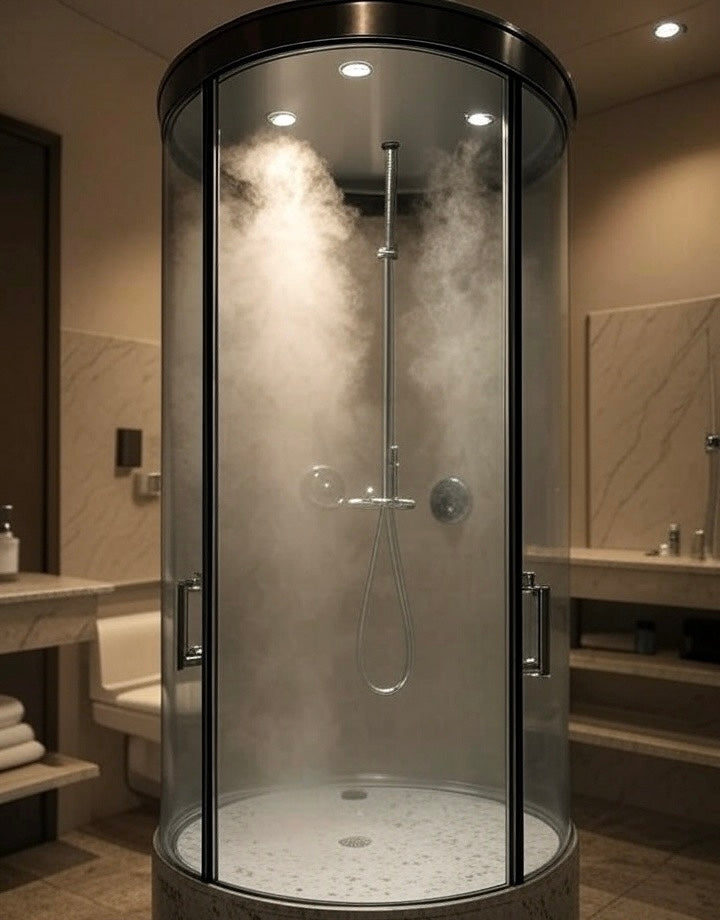Tired of overpriced spa days? Short answer: You can enjoy a steamy escape at home with a DIY Steam Room or Steam Bath setup. From health perks to spa vibes, it’s easier than you think. Keep reading to learn how to build one, stay safe, and steam like a pro.

What is a home steam room?
A home steam room is a small, enclosed space designed to fill with warm, moist air. Unlike a sauna, which uses dry heat, steam rooms maintain nearly 100% humidity.
This creates a dense, foggy atmosphere that feels both soothing and intense.
Steam room vs. Sauna
Steam Room: Uses moist heat with nearly 100% humidity.
Sauna: Uses dry heat with much lower humidity levels.
Moist heat feels more intense and is often better for breathing and congestion. Dry heat is preferred for muscle relaxation.
Benefits of using a steam room
Both can help with circulation, muscle relaxation, and stress relief.
However, steam room therapy is often more effective for respiratory issues and skin hydration. Saunas may be better suited for easing sore muscles and fatigue.
Steam rooms carry a slightly higher risk of overheating due to the trapped humidity. They also require more upkeep to prevent bacterial growth.
Saunas, being drier, pose less risk of mould but can feel dehydrating more quickly.
Two Main Approaches
Option 1: Converting an existing shower (easy/DIY method)
Many people opt for the simpler route: converting their existing shower.
This method involves adding a steam generator, sealing the space, and possibly replacing the door with a steam-tight option.
Option 2: Building a dedicated steam room (more involved)
For a true spa experience, a custom-built steam room offers more design freedom.
This involves selecting the right materials, layout, and ensuring proper installation of all components.
Planning and Preparation
Key Components of a Steam Room
Steam generator and steam head
The steam generator is the heart of your system. It heats water to create steam, which is sent into the room through the steam head.
Control unit
This lets you set temperature, session time, and even aromatherapy features. Easy access to the control unit is key for comfort.
Proper enclosure/door
To keep the steam inside, your space must be sealed.
Glass doors with rubber seals are commonly used.
Seating
Benches or foldable seats made from waterproof, heat-safe materials ensure comfort while you relax.
Essential Design and Construction Considerations
Location and space requirements
Your steam generator should be located nearby (but outside the room).
Common options include cupboards or under benches. Accessibility for maintenance is essential.
Materials and waterproofing
Use non-porous materials like tile or acrylic for walls and ceilings.
Proper sealing and waterproof membranes help prevent water damage.
Ventilation and drainage
Good airflow prevents mould. A floor drain is important to manage condensation and excess moisture.
Electrical and plumbing needs
Professional installation is recommended for wiring and plumbing.
Steam generators need both water and electrical connections.
Sizing and Cost
How to determine the right size for your space
Measure your space in cubic metres. Small rooms need less steam.
Larger rooms may require a bigger generator.
Choosing the correct generator size
Generator size depends on room volume and surface materials.
Tiled surfaces need more power compared to acrylic.
Estimating the cost of a home steam room
A DIY steam room can cost between £1,500–£4,000.
Custom builds may range from £5,000–£10,000+, depending on materials, design, and features.
Safety and Usage Guidelines

How to Use Your Steam Room Safely
Recommended session length and frequency
Limit sessions to 10–15 minutes, 2–3 times a week.
Overuse may lead to fatigue or dehydration.
Hydration and what to do if you feel unwell
Drink water before and after.
If you feel lightheaded, leave the room, sit down, and hydrate immediately.
Aromatherapy and other enhancements
Add essential oils through your steam head or a diffuser.
Lavender and eucalyptus are popular for relaxation and respiratory relief.
Maintenance and Care
Regular cleaning and preventing mould
Wipe surfaces after use and leave the door open to dry.
Weekly deep cleaning helps prevent build-up and keeps it hygienic.
Generator and system maintenance
Descale the generator every few months depending on water hardness.
Check for leaks and wear regularly to ensure safe operation.
Takeaways
-
How to steam room at home? Choose between converting a shower or building a dedicated space.
-
Plan for proper equipment, waterproofing, and ventilation.
-
Enjoy the benefits: clearer skin, better breathing, and full-body relaxation.
-
Stay safe: hydrate, keep it clean, and don’t overdo it.
Conclusion
Creating a spa-like steam room at home is easier than it sounds.
With the right tools and a little planning, you can bring the soothing experience of a steam bath into your daily routine—no spa bookings required!






